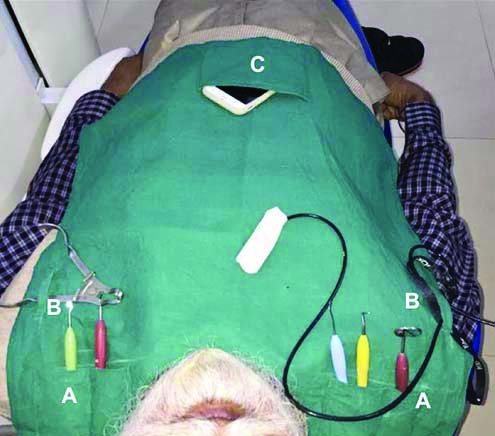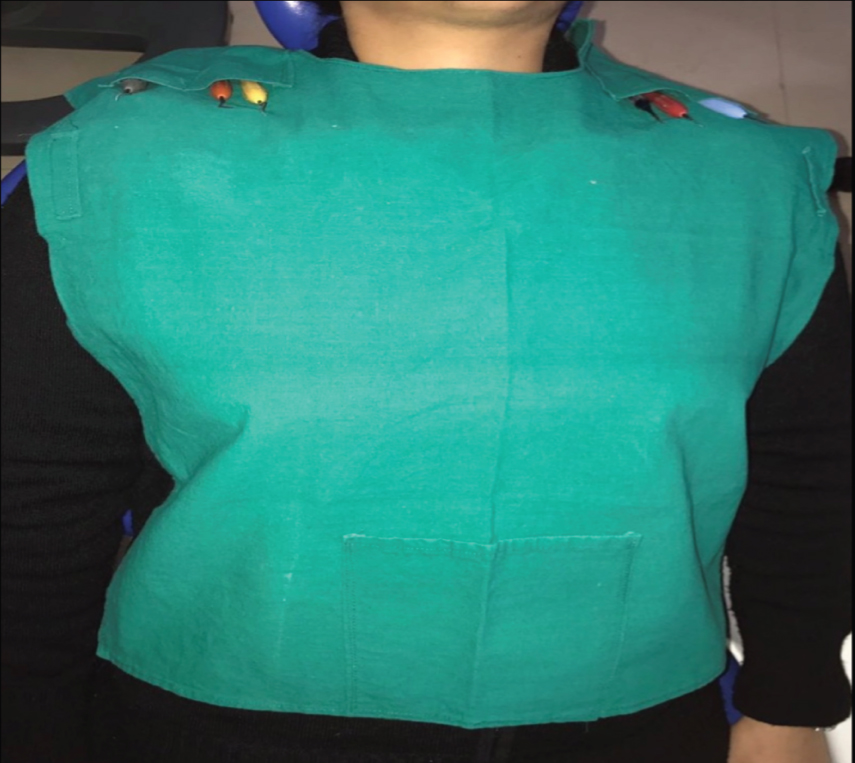Ergonomically Designed Patient Drape
Amrita Chawla1, Amrita Sujlana2, Devika Dhawan3
1 Assistant Professor, Department of Conservative Dentistry and Endodontics, AIIMS, New Delhi, India.
2 Associate Professor, Department of Peadriatic and Preventive Dentistry, BRS Dental College and Hospital, Punchkula, Haryana, India.
3 Consultant Endodontist, Sukh Iqbal Dental Center, Chandigarh, India.
NAME, ADDRESS, E-MAIL ID OF THE CORRESPONDING AUTHOR: Dr. Amrita Chawla, B3/58, Safdarjung Enclave, New Delhi-110029, India.
E-mail: dr.amritachawla@gmail.com
Patient drapes, also termed aprons or throws, are a familiar sight in the dental operatory. Conventionally available drapes used for dental procedures comprise of a rectangular-shaped cloth or waterproof material, which provides barrier protection to the patient from splatter and spills. These are held in position utilizing either straps, chains, velcro or looped straps etc., which are wound around the patients’ neck. Although drapes are primarily used for patient protection (e.g., preventing nosocomial infections), they also help to provide a sterile operating field for the dental clinician. When assessing draping procedures studies have concluded that when selecting a drape one should not only consider environment and economics, but also comfort [1]. Thus, it would prove beneficial if a simple drape would enhance dental ergonomics. Moreover, during dental procedures, the patients remain cognizant and do not want to dispense of their valuable belongings such as mobiles, wallets etc. and tend to either hold onto them or place them in their pockets. Invariably, the mobiles may slip out of the patients’ pocket/hand and be damaged in the bargain. This may result in additional anxiety in a situation which demands enhanced coping and in turn hinders patient cooperation.
We thus introduced a functionally innovative patient drape which not only provides a sterile field and optimal patient protection but also serves the following purposes:
Provision of compartments for placement of instruments within the working field of the dentist/assistant allowing easy access and enhanced productivity. These compartments are placed such that they do not compromise on patient comfort;
Caters for securing the patients’ belongings;
Provides loops for securing an apex locator;
Helps to lock the X-ray sensor of the radiovisiography, by passing the connecting wire of the sensor through a prefabricated loop.
This drape thus helps to improve ergonomics in the dental office, in turn improving productivity and providing enhanced satisfaction to both the dentist, as well as, the patient.
Detailed Description of the Drape Design
The drape consists of a reusable rectangular hemmed linen cloth with a yoke to comfortably fit around the patients’ neckline. The drape further extends onto the patients shoulder by means of shoulder straps [Table/Fig-1a,b].
In addition, we have incorporated certain compartments/pockets onto the shoulder straps providing both the clinician and assistant convenient access for placement of hand instruments. This prevents the dentist from turning away from the operating field when accessing instruments. In addition, it avoids continued and repetitive instrument exchange between the dentist and assistant.
Further, the drape also has a provision of a larger pocket at its lower extremity over the patient’s abdomen wherein he/she may place his/her personal belongings. It is located more than 47 cm away from the treatment area of the patient as it has been shown that the airborne material is spread for a distance of at least 18 inches from the operative site [2]. However, in cases needing strict asepsis, this larger pocket maybe kept free from patient’s belongings.
There is a small tag/loop provided on the right side of the drape which can be used to secure the hook of the apex locater/vitality tester when in use or secure the X-ray sensor of the Radiovisiography when taking radiographs. It can also take up other instruments such as orthodontic pliers, etc. Another such tag may also be incorporated on the left side of the drape.
When practicing four-handed dentistry it is important that the dental clinician best confine his eyes to the operating field [3]. It is also important that dental equipment be designed to best suit ergonomics and prevent work related stresses [4]. Thus, this improved ergonomic design of the simple patient drape helps both the dental clinician, as well as, the assistant work efficiently and safely, providing quality service that both the dentist and patient demand.
Ergonomically designed drape showing A. Shoulder straps with compartments for instrument placement. B. Loops for placement of holding apex locator hook/ stabilizing RVG wire/ forceps C. Pocket for patients personal belongings.

Drape further extends onto the patients shoulder by means of shoulder straps.

[1]. EA Manz, BL Edgar, Examining draping practices for cost-effectiveness Surgical Services Management 1998 4:41-47. [Google Scholar]
[2]. SK Harrel, J Molinari, Aerosols and splatter in dentistry. A brief review of literature and infection control implications JADA 2004 135:429-37. [Google Scholar]
[3]. A Gupta, M Bhat, T Mohammed, N Bansal, G Gupta, Ergonomics in dentistry Int J Pediatr Dent 2014 7(1):30-34. [Google Scholar]
[4]. H Dargahi, J Saraji, J Sadr, G Sadri, Ergonomics in dentistry J Dent Med 2009 22(4):199-207. [Google Scholar]